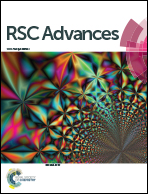Co-doped AlN nanowires with high aspect ratio and high crystal quality
Abstract
This study presents a systematic investigation of AlN:Co nanowires synthesis by a DC arc discharge plasma method that is catalyst- and template-free. X-ray diffraction (XRD), X-ray photoelectron spectroscopy (XPS), scanning electron microscopy (SEM), transmission electron microscopy (TEM) and high resolution transmission electron microscopy (HRTEM) have been used to characterize the structure, components, morphology and size of the nanowires. Raman spectroscopy revealed very symmetric and strong phonon modes, indicating very good crystal quality of the AlN:Co nanowires. Comparison of the Raman spectra of AlN and AlN:Co nanowires showed that the Co doping influenced the lattice structure, producing impurities and defects. The photoluminescence emission spectrum (PL) confirmed that the Co2+ ions existed in the AlN:Co nanowires and enhanced the optical light range and intensity of the material. A magnetic study suggested that ferromagnetism in the AlN:Co nanowires may be due to the Co ion clusters, accompanied by Al vacancies. In brief, 1D-AlN:Co nanowires were fabricated with high aspect ratio and high crystal quality and possessed excellent optical and magnetic properties. These features are very valuable for scaling up manufacturing opportunities of AlN-based DMSs and will be beneficial to manipulate and integrate these for nanodevice fabrication in spintronics.


 Please wait while we load your content...
Please wait while we load your content...